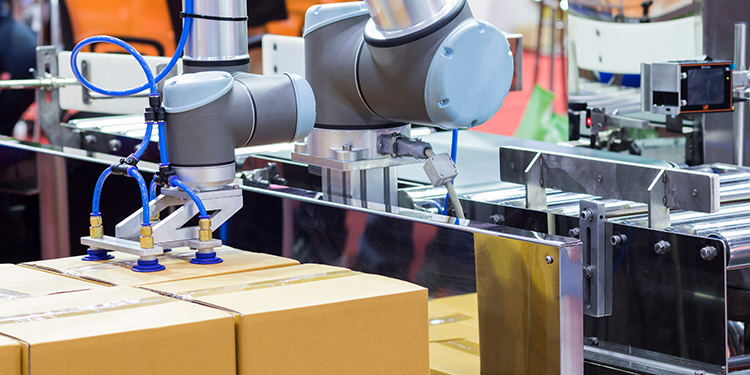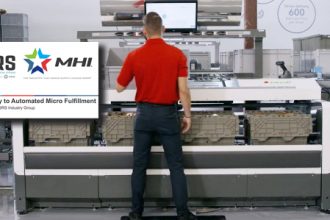5 Ways Robotics Improves Conveyor And Sortation Induction

With Covid-19 prompting an exponential surge in an online shopping trend that was already on the rise, there’s been a corresponding increase in the number of e-commerce packages and parcels shipped by retailers to consumers. Further, in an effort to minimize package size and shipping costs, more shippers are turning to flexible secondary packaging solutions — such as bags made of polyethylene and polypropylene plastic films — in addition to cardboard cartons in a range of sizes. As shoppers continue to buy more items online, from cell phones to cosmetics to food, the diversity of secondary packaging materials, shapes, sizes, forms, and weights is making it ever more difficult for operations handling these shipments to do so quickly and accurately.
Historically, shippers and carriers used manual labor to sort and induct shipments by hand onto conveyor and sortation lines as they transitioned from bulk to singulated parcel flow. Today, however, robotic induction solutions are increasingly being deployed to rotate, flip, align, and feed parcels onto these systems. Here, an exploration of how the use of automated robots improves the induction process in five different ways.
- Mitigation of Labor Woes. Virtually every industry in the U.S. is struggling to fill job openings, and material handling and supply chain operations are no exception to this trend. With qualified workers difficult to attract, hire, and retain, more operations are supplementing their current labor force with robotic solutions that help achieve higher productivity in parcel induction without expanding headcount.
- Greater Speed and Accuracy. The more complicated a task becomes, the more difficult it is for a human to accomplish it at a high rate of speed. When parcel induction only involved manually pushing similarly sized polybags in one direction and cartons in another, associates could easily keep up with productivity expectations. But the expanded variety of products, package types, sizes, and weights being shipped has become complicated enough to slow human operators down. Robots, however, are equipped with versatile end of arm tooling — such as vacuum cups or grippers — and sophisticated vision sensors capable of identifying and maneuvering an exponential diversity of parcels at significantly higher rates than their human counterparts.
- Fast Return on Investment (ROI). As robotic technologies, including those designed for induction, have grown more sophisticated and advanced their costs have come down significantly. This makes them vastly more accessible to a larger range of operations. They also require less specialized training than older robotic systems to both program and maintain. Conversely, the cost of labor has continued to rise. All of these factors reduce payback time for an investment in robotic induction from what used to be as long as 10 years to now two or three years, depending on the application.
- Space Savings. Today’s automated robotic induction solutions frequently utilize collaborative robots, also known as cobots. These robots are specifically engineered to work safely alongside their human colleagues. Outfitted with safety sensors that detect the proximity of a human and trigger the robot to slow its speed and force, the risk of a collision is eliminated. The upshot is, unlike conventional robotic automation solutions of the past, no protective guarding or isolated work cells are required to separate the robot from associates, freeing up valuable floorspace for other uses. Further, the presence of a worker does not signal the robot — and therefore the entire production process — to stop running, which ensures sustained productivity.
- Easy Deployment and Continuous Improvement. Today’s robotic induction solutions are simple, easy to program, and can be quickly implemented with little to no specialized training required. Additionally, many incorporate artificial intelligence (AI) and machine learning (ML) algorithms, enabling them to learn during their operation. For example, every time the robot picks up a specific package type presented in a unique orientation, it learns how to better handle and transfer that kind of item from point A to point B in a more efficient and effective way the next time. By continuously learning how to handle items with more competence over time, the robot becomes more adept and faster at doing so, enhancing overall productivity.
Ready to integrate robotics or automation with your existing conveyor or sortation system? Learn how to ensure a successful implementation with these best practice recommendations for successful project management from the members of the Conveyors and Sortation Systems (CSS) Industry Group of MHI.
The 30-plus CSS members are the industry’s leading providers of conveyors and sortation systems. They have completed thousands of projects ranging from small, initial automation investments to large, complex projects synthesizing integrators, multiple vendors, and different municipalities. They design, fabricate, and install conveyor and sortation systems worldwide and in virtually every major manufacturing and distribution sector. Additional resources on robotic solutions, including those used for induction, are available via The Robotics Group of MHI, and at The Robot Report.



